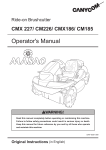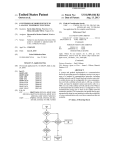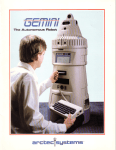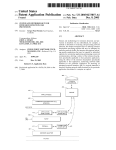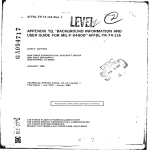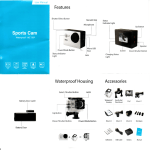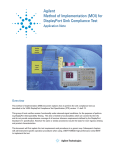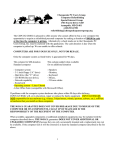Download ( Sta rt D
Transcript
US 20130133044Al
(19) United States
(12) Patent Application Publication (10) Pub. No.: US 2013/0133044 A1
MORRISON et a].
(54)
(43) Pub. Date:
SELF-PROPELLED HARVESTING VEHICLE
(52)
INCLUDINGA THERMOCHEMICAL
May 23, 2013
US. Cl.
USPC .................................... .. 726/5; 726/25; 726/2
REACTOR FOR CARBONIZING HARVESTED
CROP MATERIAL
(57)
(75) Inventors: John S. MORRISON, Crownsville, MD
(Us) Kyle J‘ Roach Hanover MD (Us)
’
’
A.system
method are provided fOr.€.:mp1Oying.a hand-held
w1re~less dev1ce to assess a vulnerability of a wirelessly-ac
’
cesslble target network to mtrusion and/or cyber-attack. The
(73)
Assigneez LOCKHEED MARTIN
CORPORATION B ethes da MD (Us)
(21)
Appl_ No; 13/300,020
(22)
Filed;
’
ABSTRACT
system and method are directed at providing discrete, covert
and fully-automated wireless access to the target network via
’
one or more wireless access points and to assessing charac
teristic of the one or more wireless access points and the target
network in support of a vulnerability assessment. The hand
N0“ 18, 2011
held wireless device is con?gured to collect appropriate data
regarding the wirelessly-accessible network, including net
Publication Classi?cation
(51)
Int. Cl.
H04L 29/06
G06F 11/00
work and portal scans, and higher-level programmed data
collection. The hand-held wireless device is further con?g
ured to analyze the collected data and to produce at least a ?rst
level vulnerability assessment of the target network without
interaction by the user.
(2006.01)
(2006.01)
93600
(
Sta rt
D
|
53100
Obtain Signal ‘in Commence Wireless Access
To Target Network For Assessment
53200
I
Collect And Record Target Wireless Access Point
Characteristics At Predeterminecl Intervals
53300
Is Target
Wireless Access Point
Secured?
S3400
Attempt Connection the Target Wireless Access
Point Using Common Authentication Passwords
-
~
,
~
5359”
Connect To Target Network Via Target Wireless
Access Point And Perform Scan Of Target
Network Ami Portals
S3500
Perform Additional Collection Functions Via
l
Target Wireless Access Point {As Appropriate)
S3769
Assessment
NU
Completion Criterion
Satisfied?
5380a
Analyze Collected Data Regarding Target
Eel-work and Portals
|
53900
-
Display Arid! 0:‘ Export Data And Assessment
Results (As Appropriate}
54608
(
Stop
D
Patent Application Publication
May 23, 2013 Sheet 1 0f 3
LBCB§
N eiwariaed
Cnmguting
Envi
men-t
.1 10
FIG. 1
US 2013/0133044 A1
i 3 anC
Patent Application Publication
May 23, 2013 Sheet 2 0f 3
US 2013/0133044 A1
210
I —
220
—
—
—
—
—
—
25“
_
359‘
—|
U H
I
I
Qata Extraction
2TH |
|
i '
I
and Anaiiysis Unit
|
|
|
Posiétian
|
22::
l
Reference
I
Extras-‘?an
|
?evice-
|
Device
I
"
.
:
7240
—
xntes?ate
l
23“
—
|
21-2
l
Precassar
|
I
|
|
I
|
!
|
Analysis???‘li'h
have;
Assessment
I
I
Eats
Srtm‘age
|
|
Bevice
I
I
Bevice
|
.Externai Data
Eammuniicatiun
interfame
EM
I
I
I
Data
293‘
FIG. 2
?utputf?isgiay 2.30
Device
Patent Application Publication
5335M!
53mm
May 23, 2013 Sheet 3 0f 3
(
US 2013/0133044 A1
Sta rt
D
Obtain Signai Tn Commence Wireiess Access
To Target Network For Assessment
|
532GB
.
.
i.
.
Ce?ect And Rec-0rd Target Wweiess Access FDR“;
Characteristics .Ait predetermined Intervais
53386
Is Tar-get
Wireiess Access Paint
Secured?‘
Attemst (Sienna-stint: Via Target Wireiess .hecess
Point Using Common Authentic‘atien Pssswer?s
S3590
Connect Te Target Netwnrk Vie Target Wireiess
Access Paint And Perform Scan Of Target
Netwurk Ami Pertais
535m}
Perferm Additionei Coiiection Functiens ‘Vie
l
Target Wireiess Access Point {As Apprepriete}
531cm
Assessment
Defamation Criterion
NH
’
Satis?ed?
S3380
Assiyzze (In?ected Esta Regarding Target
Network and Pertais
l
53mm
-
.
Dismay Andf?r Expert Data An? Assessment
Resu?s {As Apprnpriate}
FIG. 3
May 23, 2013
US 2013/0133044 A1
SELF-PROPELLED HARVESTING VEHICLE
INCLUDING A THERMOCHEMICAL
REACTOR FOR CARBONIZING HARVESTED
CROP MATERIAL
BACKGROUND
[0001] 1. Field ofthe Disclosed Embodiments
[0002] This disclosure relates to systems and methods for
using hand-held Wireless devices to discretely scan for Wire
less access points and to collect various details regarding the
scanned Wireless access points and the netWorks that are
accessible via those scanned Wireless access points. The col
lected various details may include basic security implemen
tations, signal strengths and other like details regarding the
scanned Wireless access points and netWorks.
[0003]
2. RelatedArt
[0004]
All manner of Wireless devices are used to access
various netWorks and netWork-connected systems via ran
dom Wireless access points. There has emerged a need for
entities to accurately assess certain characteristics regarding
speci?c Wireless access points and the netWorks that are
accessible via those Wireless access points.
[0005]
These assessment capabilities can be used to a num
ber of bene?cial purposes. Among the bene?ts of assessing
characteristics of a particular Wireless access point is to assist
commercial enterprises operating local networks, govem
ment agencies and laW enforcement entities in performing
overall vulnerability assessments on networks, and the sys
tems connected thereto, that may be accessed through one or
more Wireless access points.Vulnerability assessments canbe
used to determine Weaknesses in particular target local net
Works, or devices connected to the target local netWorks, in
order to evaluate susceptibility of the a particular target net
Work, or individual device in communication With the par
ticular target netWork, to cyber-attack.
[0006] Conventionally, vulnerability assessments have
been carried out on speci?c netWorks, or otherWise in speci?c
netWork environments, using desktop computer systems or
laptop computers. For example, existing programs for per
trained operator Whose manipulation of the system is gener
ally required to provide effective assessment and analysis of
the results.
[0008] Adding to the above physical draWback in employ
ing such conventional systems and methods is that the use of
these clearly visible conventional devices, most often intro
duced into the netWork environment by the equally conspicu
ous outside assessor, can cause disruption in the netWork/
Workplace environment in Which the evaluation device is
employed. In such instances, users and administrators alike
have been knoWn to modify systems and/ or individual behav
iors When it is clear from the use of conspicuous methods and
systems that some sort of assessment is underWay.
[0009] This modi?cation in behavior by individuals oper
ating monitored systems and netWorks can have adverse
effects on the results of any evaluation, Which can be at least
in part attributed to the conspicuously-undertaken nature of
the assessment. The results of any evaluation can be, for
example, improperly skeWed, thereby lessening the effective
ness of the assessment.
[0010]
Additionally, use of additional conspicuous evalua
tion devices in certain secure environments can cause an
individual assessor to be harassed, or otherWise bothered, by
individual system operators and/or regular security person
nel, the latter including being independently detained While
access and equipment protocols receive heightened scrutiny.
[0011] Another conventional manner by Which vulnerabil
ity assessments are undertaken is through installation of spe
ci?c hardWare appliances installed on-site to perform routine
vulnerability scans on the connected netWork and any devices
connected to the netWork. DraWbacks to this conventional
solution include that such hardWare installations tend to be
less agile and are rarely accessible by entities outside the
speci?c organiZation, such as a company, that operates or
maintains the local netWork.
SUMMARY OF THE DISCLOSED
EMBODIMENTS
[0012] Many currently-available commercial-off-the-shelf
sonal computers are available to perform extensive vulner
ability scans on netWorks of computers. One example of such
a system Was developed by Tenable NetWork System and is
bilities to access various netWorks via random Wireless access
marketed under the trade name Nessus® as a proprietary
tain details regarding access to the Wireless access point.
comprehensive vulnerability scanning program. These vul
nerability assessment systems include capabilities to detect,
alloW them to scan for Wireless netWork access points, or to
for example, potential vulnerabilities on tested netWork sys
perform netWork and port scans. These devices can collect
tems that may alloW an intruder into the netWork to gain
details that may include basic level security implementations
and/or signal strengths of the Wireless access points. In this
access to, and potentially exercise control of, sensitive data in
a particular targeted netWork system. These vulnerability
assessment systems may also detect other areas of exposure
including, for example, Weaknesses in passWord protocol, to
hand-held Wireless devices, such as smartphones, have capa
points. These devices further have capabilities to gather cer
Speci?cally, there are applications for these devices that
regard, information such as that Which is collected by con
ventional vulnerability assessment means can be collected by
these standard commercial hand-held Wireless devices. To
include existence of common, default or missing passWords.
date, hoWever, there is generally no application for these
[0007] Signi?cant draWbacks exist in these conventional
vulnerability assessment systems. Such conventional vulner
ability assessment systems are generally very extensive
requiring excessive time, and manipulation by a trained
commercial hand-held devices to automate the process or to
operator, in order to provide an accurate assessment. These
conventional vulnerability assessment systems also generally
link together, for example, access point scanning With more
detailed netWork/port scanning.
[0013] It Would be advantageous in vieW of the above
identi?ed draWbacks in conventional systems and methods
require signi?cant computing poWer. It is for this reason that
for performing vulnerability assessments, and in vieW of the
capabilities of modem-hand-held Wireless device, to provide
the conventional vulnerability assessment systems are gener
an individual user or user entity With a simple, portable,
ally hosted on a large and conspicuous speci?cally-con?g
ured desktop and/or laptop computer. These computer sys
discrete and generally automated system and method for con
ducting at least ?rst level vulnerability assessments on par
tems are rendered more conspicuous When they are
ticular Wirelessly-accessible netWorks. The disclosed sys
introduced into the netWork/Workplace environment by a
tems and methods may obviate the requirement for the use of
May 23, 2013
US 2013/0133044 A1
cumbersome, conspicuous, and specialized equipment, gen
methods according to this disclosure is that the disclosed
erally in the form of a desktop or laptop computer, With a
particular operator, to access particular networks via Wireless
access points to perform vulnerability assessments.
discrete vulnerability detection means that the user of the
local hand-held Wireless device can detect such vulnerabili
[0014]
In various exemplary embodiments, the systems and
methods according to this disclosure may provide a simple
solution via a user’s oWn local hand-held Wireless device,
such as a commercially-available smartphone, tablet, PDA or
the like, to discretely and automatically access a particular
target netWork via one or more Wireless access point to assess
characteristics of the target netWork and the Wireless access
points. The assessment of these characteristics may advanta
geously provide a basis for, for example, a vulnerability
assessment of the target netWork.
[0015]
In various exemplary embodiments, the systems and
methods according to this disclosure may provide govem
ment agencies and laW enforcement entities With a capability
to discretely collect data regarding a particular target netWork
and/or Wireless access point associated With the target net
Work and to determine the target netWork’s potential for sus
ceptibility to cyber-attack.
[0016] In various exemplary embodiments, the systems and
ties in a given target netWork Without alerting users of the
netWork to the ongoing assessment process. As such, users of
the netWork Will likely be completely unaWare that any vul
nerability assessment is being undertaken. Another advantage
of the systems and methods according to this disclosure is that
they are capable of being implemented on most off-the-shelf
Wireless hand-held devices, including, but not limited to
smartphones, tablets and PDAs having a Wireless (Wi-Fi)
receiver.
[0021] In various exemplary embodiments, the systems and
methods according to this disclosure do not require signi?
cant computing poWer, or otherWise, speci?c training for an
assessor. The simplicity of the systems and methods accord
ing to this disclosure is their ability to be implemented on
virtually any commercially-available hand-held device that
includes at least a Wi-Fi receiver, and to perform at least the
data collection Without interaction With the assessor.
automatically perform at least a basic vulnerability assess
[0022] In various exemplary embodiments, systems and
methods according to this disclosure may also provide higher
level settings to perform additional assessment options under
a concept of Analysis Depth Level (ADL). Depending on the
ADL, the process may be speci?cally automated to perform
ment in a manner that Will not be skeWed by individual system
participants’ modi?cation in their behavior based on a con
potential passWords for the individual access points, Wireless
methods according to this disclosure may provide a capability
using a Wireless (Wi-Fi) receiver in a user’s oWn local hand
held Wireless device, such as a smartphone, tablet or PDA, to
spicuous presence of a particular assessor, and associated
assessment equipment, While conducting the vulnerability
connection to individual access points, determinations of
packet capture and Wired Equivalent Privacy (WEP) crack
mg.
assessment.
[0023]
[0017]
In various exemplary embodiments, the systems and
sure may provide a level of automation to the assessment that
methods according to disclosure may generally alloW a user
to manually commence netWork assessment via a speci?c
Would alleviate virtually all interaction betWeen the assessor
Wireless access point by activating an automated capability
and the assessing device in completing the assessment. Such
automation Would have the bene?t of affording the assessor
stored Within the user’ s oWn local hand-held Wireless device.
Information regarding one or more Wireless access points
an opportunity to simply begin the assessment by activating a
Wholly-automated process via a hand-held device, placing the
hand-held device in, for example, a pocket or bag, and Walk
may be automatically recorded by the user’ s oWn local hand
held Wireless device at speci?ed intervals such as, for
example, each 1 to 2 seconds.
The systems and methods according to this disclo
ing through a target area in Which the vulnerability assess
ment is to be undertaken. Data Would be collected autono
mously by the hand-held device as the assessor simple passes
through the area.
[0018]
In various exemplary embodiments of the systems
and methods according to this disclosure, the user’s oWn local
hand-held Wireless device may provide an initial ?rst level
vulnerability assessment of a particular netWork of interest, or
devices connected to the netWork, in order that a government
agency, or laW enforcement entity, may be provided With
information appropriate to later run a cyber-attack on the
particular netWork of interest.
[0019] In various exemplary embodiments, the systems and
methods according to this disclosure may provide a capability
for a user’s oWn local hand-held Wireless device to scan
Wireless access points such as, for example, Wi-Fi access
points, to gather various details regarding the scanned Wire
less access points. The details may include, for example, basic
levels of security implementation, signal strengths or other
[0024]
Depending on a level of sophistication of the ADL,
if the Wireless access point is unsecured, the user’s oWn local
hand-held Wireless device may automatically connect to the
netWork and perform netWork and/ or port scans. OtherWise, if
the Wireless access point is secured, and the level sophistica
tion of the ADL supports such a capability, the user’s oWn
local hand-held Wireless device may attempt to connect to the
netWork using one or more common authentication pass
Words. Again, depending on the level of sophistication of the
ADL, the user’s oWn local hand-held Wireless device may
perform some level of Wireless packet collection and/or WEP
cracking via the accessed netWork.
[0025] In various exemplary embodiments, the user may
then manually terminate the collection portion of the assess
ment process, or the entire assessment process. OtherWise,
the collection process may be automatically stopped based on
an elapsed time, or according to some other predetermined
collection criterion.
like data that may be gathered With an appropriately-auto
[0026]
mated user’s oWn local hand-held Wireless device.
methods according to this disclosure may also provide an
In various exemplary embodiments, the systems and
In various exemplary embodiments, the systems and
ability to basically analyZe the gathered data, or to otherWise
methods according to this disclosure may additionally pro
vide a simple, discrete solution to assessing the vulnerabili
ties of a particular netWork. An advantage of the systems and
generate a detailed assessment report for export in a form that
is usable by the user, or usable by an agency or entity to Which
the user may communicate such a report.
[0020]
May 23, 2013
US 2013/0133044 A1
These and other features, and advantages, of the
?gurations may be used Without departing from the spirit and
disclosed systems and methods are described in, or apparent
scope of the subject matter of this disclosure.
[0035] Various aspects of the disclosed embodiments relate
to a system and a method for discretely and automatically
[0027]
from, the following detailed description of various exemplary
embodiments.
assessing characteristics of a target netWork, particularly
BRIEF DESCRIPTION OF THE DRAWINGS
[0028] Various exemplary embodiments of the disclosed
systems and methods for discretely and automatically assess
ing a netWork vulnerability using a user’s oWn local hand
held Wireless device accessing the netWork via one or more
Wireless access points Will be described, in detail, With refer
ence to the folloWing draWings, in Which:
[0029]
FIG. 1 illustrates a schematic diagram of an exem
plary Wirelessly-accessible local computer netWorked envi
ronment With Which the systems and methods according to
this disclosure may operate;
[0030] FIG. 2 illustrates a block diagram of an exemplary
system for discretely and automatically assessing a Wire
lessly-accessible netWork according to this disclosure; and
[0031]
FIG. 3 illustrates a ?owchart of an exemplary
those characteristics that may indicate vulnerabilities of the
target netWork and the devices connected thereto, to unautho
riZed intrusion, up to and including cyber-attack, using a
user’s oWn local hand-held Wireless device for accessing the
target netWork via one or more Wireless access points. The
user’s oWn local hand-held Wireless device may be autono
mously employed for signal detection, Wireless netWork
access and a speci?c level of netWork analysis using an
adapted program stored in, or executed by, the user’s oWn
local hand-held Wireless device. The systems and methods
according to this disclosure may employ a corresponding
computer-readable medium, With a program stored thereon,
Which is accessible to the user’ s oWn local hand-held Wireless
device for execution.
[0036]
The disclosed embodiments may be advantageously
method for discretely and automatically assessing a Wire
lessly-accessible netWork according to this disclosure.
operated in a local computing environment. In this regard, a
user’s oWn local hand-held Wireless device may be operated
Within the local computing environment discretely and auto
DETAILED DESCRIPTION OF THE DISCLOSED
EMBODIMENTS
user, or even an administrator, of the local computing envi
ronment to be made aWare that an external assessment of any
[0032] The systems and methods for discretely and auto
matically assessing a Wirelessly-accessible netWork accord
ing to this disclosure Will generally refer to this speci?c utility
for those systems and methods. Exemplary embodiments
matically so as to minimize or eliminate an opportunity for a
kind, including an assessment of a vulnerability of the local
computing environment to intrusion is ongoing.
[0037]
FIG. 1 illustrates a schematic diagram of an exem
described and depicted in this disclosure should not be inter
plary local netWorked computing environment 100 With
Which the systems and methods according this disclosure
preted as being speci?cally limited to any particular con?gu
may operate. As shoWn in FIG. 1, and as is commonly under
ration, or directed to any particular intended use. In fact, any
discrete detection, access and assessment tasks using, for
example, a user’s oWn local hand-held Wireless device for
ment 100 may include any combination of a plurality of
Workstations 130A-G of various types coupled to, or in direct
stood, the exemplary local netWorked computing environ
accessing a target netWork via one or more Wireless access
or netWorked communication With, one or more servers
points that may bene?t from a part or all of the systems and
methods according to this disclosure are contemplated.
140A-B. Individual components of the exemplary local net
Worked computing environment 100 may be individually
[0033] Speci?c reference to, for example, any particular
Wireless device, including any particular hand-held Wireless
device, should be understood as being exemplary only, and
connected to each other, or otherWise in communication With
not limited, in any manner, to any particular class of devices.
The systems and methods according to this disclosure Will be
described as being particularly adaptable to being hosted on
common
commercial-off-the-shelf
hand-held
Wireless
devices such as smartphones, tablets, PDAs and the like, but
should not be considered as being limited to only these
devices. Any common Wireless computing device that may be
particularly discretely concealed by a user, and Which may be
each other via some sort of central mainframe (not shoWn), by
combinations of Wired and Wireless communication betWeen
individual elements.
[0038] A user’s oWn local hand-held Wireless device 110
may be provided to communicate With the exemplary local
netWorked computing environment 100 via one or more Wire
less access points 120A-C. The user’s oWn local hand-held
Wireless device 110 may be con?gured to randomly search for
available Wireless access points and to connect With the exem
plary local netWorked computing environment 100 via those
adapted according to the speci?c capabilities discussed in this
disclosure is contemplated as being covered by the folloWing
Wireless access points 120A-C. It is based on this ability of
such an exemplary user’s oWn local hand-held Wireless
description.
[0034] Individual features and advantages of the disclosed
systems and methods Will be set forth in the detailed descrip
tion that folloWs, and Will be, in part, obvious from the
detailed description, or may be learned by practice of the
device 110 to communicate directly With the exemplary local
netWorked computing environment 100 via any Wireless
access point that represents the portal by Which the local
netWorked computing environment 100 may susceptible to
intrusion.
features described in this disclosure. The features and advan
tages of the systems and methods according to this disclosure
[0039] The user’s oWn local hand-held Wireless device 110
may constantly or periodically attempt to access the exem
may be realiZed and obtained by means of the individual
plary local netWorked computing environment 100 according
elements, and combinations of those elements, as particularly
to a predetermined access scheme. The user’s oWn local hand
pointed out in the appended claims. While speci?c implemen
held Wireless device 110 may be available according to the
tations are discussed, it should be understood that this is done
details beloW to assess (1) an ability to connect to the exem
for illustration purposes only. A person of ordinary skill in the
plary local netWorked computing environment 100 via one or
more Wireless access points 120A-C, Whether passWord-pro
relevant art may recogniZe that other components and con
May 23, 2013
US 2013/0133044 A1
tected or not; (2) a strength of a signal received from the one
or more Wireless access ports 120A-C; and (3) an oWn
device’s ability to scan the local networked computing envi
ronment 100, including individual portals and devices con
nected thereto, and to capture Wireless packets as such capa
bilities are available in the user’s oWn local hand-held
little, if any, additional user interaction While the system 210
performs the automated data collection and assessment func
tions. The user interface 220 may include, for example, an
integral keyboard by Which the user may communicate With
the system 210. In exemplary embodiments, a speci?c user
interface 220 may include simply a “hot key” for activating
Wireless device 110.
[0040] It should be noted that each of the Wired and Wireless
data communications lines betWeen the various components
shoWn in FIG. 1 are unnumberedbecause one of ordinary skill
in the art Will recogniZe that such internal communications
could be displayed and/or depicted in a virtually a limitless
combination of connections betWeen individual components
and devices, as displayed in exemplary manner attached to the
the speci?c assessment methodology according to this dis
exemplary local netWorked computing environment 100
embodied in the system 210.
shoWn in FIG. 1.
[0041] As Will be discussed in detail beloW, once the user’ s
oWn local hand-held Wireless device 110 gains access to the
exemplary local netWorked computing environment 100, the
user’ s oWn local hand-held Wireless device 110 may be manu
ally activated by the user to commence a process by Which the
user’s oWn local hand-held Wireless device 110 connects to
various components, Whether passWord-protected or not to
assess the vulnerability of those individual components to, for
example, cyber-attack or other intrusion into the exemplary
local netWorked computing environment 100. In this manner,
closure. The user interface 220 may alternatively include (1)
a touchscreen With “soft” buttons; (2) various components for
use With a compatible stylus; (3) a microphone by Which a
user may provide oral commands to the system 210 to be
“translated” by a voice recognition program or otherWise; or
(4) other like device for user activation of, and communica
tion With the data collection and analysis methodology
[0044]
The system 210 may optionally include one or more
position reference devices 230. Such position reference
devices 230 may comprise a GPS receiver for receiving glo
bal positioning satellite location information to the system
210, and/ or may include an inertial navigation system or other
like device that can localiZe the position of the system for use.
Information regarding a position of the system 21 0 may prove
bene?cial in providing additional data Which may be of use in
the assessment of the speci?c target netWork system, particu
larly With regard to the position of any speci?c Wireless
access point that is accessed by the system 210.
at least a ?rst level vulnerability assessment may be autono
[0045]
mously performed by a user by simply activating the process
processors 240 for individually operating the system 210 and
carrying out data collection, processing, assessment and con
With the user’s oWn local hand-held Wireless device 110 and
further simply remaining in range of the one or more Wireless
access points 120A-C such as, for example, by simply Walk
ing through a physical area covered by the Wirelessly-acces
sible local netWorked computing environment 100.
[0042]
FIG. 2 illustrates a block diagram of an exemplary
system for discretely and automatically assessing a Wire
lessly-accessible netWork according to this disclosure. The
exemplary system 210 shoWn in FIG. 2 may be embodied in,
for example, the user’s oWn local hand-held Wireless device
110, such as that discussed above With reference to FIG. 1.
OtherWise, portions of the exemplary system 210 shoWn in
FIG. 2 may be housed in a remote location, such as remote
server (not shoWn) With Which the user’s oWn local hand-held
Wireless device 110 may be in electronic communication. An
objective of the systems and methods according to this dis
closure, hoWever, is to house the data acquisition, processing
and analysis functions locally in the user’s oWn local hand
held Wireless device 110. This objective supports a goal of
providing discrete and autonomous assessment of the Wire
lessly-accessible netWork by a user’s oWn local hand-held
Wireless device 110 (see FIG. 1) to determine susceptibility of
the Wirelessly-accessible netWork to intrusion and cyber-at
tack. In this regard, the system 210 may be housed in virtually
any commercial-off-the-shelfhand-held Wireless device such
The system 210 may also include one or more local
trol functions such as those that Will be described in detail
beloW. Processor(s) 240 may include at least one conven
tional processor or microprocessor that interprets and
executes instructions to direct speci?c data collection and
storage functions With regard to any speci?c target Wireless
netWork. Processor(s) 240 may initiate and control of the data
collection and analysis efforts of the system 210 once those
efforts are initiated by, for example, manual input by a user
via the user interface 220. The data collection and analysis
efforts, once initiated, may be controlled by the processor(s)
240 to continue for some predetermined period of time, or
until some other predetermined data collection criterion is
met, at Which point the processor 240 may suspend the data
acquisition and/or analysis functions. It should also be under
stood that the processor(s) 240 may control only the data
acquisition process, While analysis and assessment may need
to be separately undertaken either locally or in communica
tion With, for example, a remote server (not shoWn).
[0046]
The system 210 may include one or more data stor
age devices 250. Such data storage device(s) 250 may be used
to store data or operating programs to be used by the system
210, and speci?cally the processor(s) 240. Data storage
device(s) 250 may be used to collect information regarding,
for example, signal strengths, security implementations and
as, for example, a smartphone, a tablet, a PDA or other like
other related information regarding Wirelessly-accessible
device.
[0043] The system 210 may include a user interface 220 by
Which the user may communicate With the system 210. The
netWorks. The data storage device(s) 250 may facilitate the
collection of data in an initial inconspicuous data collection
user interface 220 may be con?gured as one or more conven
remove the system 210 to a remote location in order to pro
tional mechanisms common to hand-held Wireless devices
such as those listed above. The user interface may permit a
vide some level of detailed analysis of the collected data.
[0047] Data storage device(s) 250 may include a random
access memory (RAM) or another type of dynamic storage
user to input information to the system 210 in order to, for
example, to activate an assessment methodology according to
this disclosure. An objective of such activation Would be to
simply begin an automated assessment process requiring
sWeep performed by a user, and store such data for the user to
device that is capable of storing collected information, and
separately storing instructions for execution of system opera
tions by, for example, processor(s) 240. Data storage device
May 23, 2013
US 2013/0133044 A1
(s) 250 may also include a read-only memory (ROM), Which
the vulnerability of the accessed netWork, and/or devices
may include a conventional ROM device or another type of
connected to the accessed netWork.
static storage device that stores static information and instruc
[0051]
tions for processor(s) 240. Further, the data storage device(s)
be provided to perform higher-level interrogations. For
250 may be integral to the system 210, or may be provided
external to, and in Wired or Wireless communication With, the
cause or control the system 210 to attempt connections to
system 210.
[0048]
The system 210 may include one or more external
data communication interfaces 260 by Which the system 210
may communicate With components external to the system
210, such as the exemplary Wirelessly-accessible local net
Worked computer environment 100 shoWn, for example, in
FIG. 1. Principal external data communication for the system
210 Will generally be via at least one external data commu
nication interface 260 con?gured to detect and communicate
With one or more Wireless access points, such as those
depicted as elements 120A-C in FIG. 1. In other Words, a
speci?ed one of the external data communication interfaces
260 may be con?gured as a Wi-Fi receiver usable to detect
signals indicative of Wireless access points to collect charac
teristic information regarding target Wireless access points, to
particularly assess at least a signal strength, e.g., Received
Signal Strength Indication or RSSI, and, Where appropriate,
information on security implementations that may later be
usable to assess a vulnerability of a particular Wirelessly
accessible netWork to intrusion and attack. Otherwise, the one
or more external data communications interfaces 260 may
include any mechanism that facilitates direct communication,
or communication via a network environment, for the sharing
of results of the processing, collection and analysis under
taken by the system 210.
[0049]
The system 210 may also include a speci?c data
analysis and extraction unit 270 as a part of a processor 240
coupled to, for example, one or more storage devices 250, or
as a separate component module or circuit in the system 210.
The data analysis and extraction unit 270 may include at least
a basic data extraction device 272 and an analysis depth level
assessment device 274. As With all of the components of the
system 210, the data analysis and extraction unit 270, With its
basic data extraction device 272 and analysis depth level
assessment device 274, is preferably housed locally in a
user’s oWn local hand-held Wireless device, but portions of
data analysis and extraction unit 270 may be housed on a
remote server (not shoWn). In this manner, speci?c data col
lection may be undertaken locally under control of, for
example, one or more processor(s) 240 in the system 210,
An analysis depth level assessment device 274 may
example, the analysis depth level assessment device 274 may
Wireless access points, Which may or may not be secured, i.e.,
passWord-protected. Depending on a robustness in the pro
gramming of the exemplary analysis depth level assessment
device 274, functions such as, for example, determining
Whether a Wireless access point is secured or otherWise unse
cured may be undertaken. In instances Where a Wireless
access point is unsecured, the analysis depth level assessment
device 274 may execute functions required to connect to the
netWork via the Wireless access point and perform netWork
and/or portal scans. Again, depending on the details of the
functions provided by the analysis depth level assessment
device 274, in instances Where a Wireless access point is
determined to be secured, the analysis depth level assessment
device 274 may attempt to execute connection With the net
Work using common authentication passWords. These com
mon authentication passWords may, for example, be stored in
one or more data storage devices 250. Further, and again
depending on the program functionality, the analysis depth
level assessment device 274 may execute functions to per
form, for example, data packet collection and/or WEP crack
ing. As indicated above, is intended that, once initiated, the
data collection and at least ?rst level analysis may be provided
locally by the system 210 covertly carried by a user in the
targeted, Wirelessly accessible local computing netWork envi
ronment (see FIG. 1).
[0052] The system 210 may include at least one data out
put/display device 280 Which may be con?gured as one or
more conventional mechanisms that output information to the
user, including a display screen on the user’s oWn local hand
held Wireless device. The data output/ display device 280 may
separately be an output port for connection to a printer, a
copier, a scanner, a multi-function device, or a remote storage
medium, such as a memory in the form, for example, of a
magnetic or optical disk With a corresponding disk drive or
otherWise a remote server as discussed above. In instances
Where only the data collection functions are undertaken
locally With the system 210, at least one data output/display
device 280 may be speci?cally used to facilitate doWnload of
collected data regarding the one or more Wirelessly-acces
sible targeted netWorks in order that the analysis of the col
lected data, to include further analysis depth level assessment,
While analysis functions may occur at a remote location
or data export to a user may be accomplished on a separate
Where data collected from a speci?cally targeted netWork by
the system 210 may be computer analyZed in more detail
computing platform. Any suitable data connection in Wired or
manner. As indicated above, a speci?c objective of the sys
tems and methods according to this disclosure remains, hoW
ever, to house all of the required components for vulnerability
assessment and analysis of a Wirelessly-accessible netWork
Within the user’s oWn local hand-held Wireless device 110
Wireless communication With an external data repository or
external data analysis unit is contemplated to be encompassed
by the at least one data output/display device 280.
[0053] All of the various components of the system 210, as
depicted in FIG. 2, may be connected by one or more data/
control busses 290. These data/control busses 290 may pro
(see FIG. 1), Which can be inconspicuously carried and oper
ated to perform the data acquisition and analysis discussed in
vide Wired or Wireless communication betWeen the various
this disclosure.
components of the system 210, Whether all of those compo
The basic data extraction device 272 may be pro
nents are housed integrally in, or are otherWise external and
connected to, the user’ s oWn local hand-held Wireless device.
vided to perform rudimentary signal acquisition tasks includ
ing (1) basic signal strength assessment; and (2) basic secu
FIG. 2 as an integral unit, the various disclosed elements of
rity implementations interrogation of a target Wireless access
the system 210 may be arranged in any combination of sub
point or a target netWork. The basic data extraction device 272
may, therefore, provide a ?rst level of data for assessment of
ponents, integral to a single unit, or external to, and in Wired
[0050]
[0054] It should be appreciated that, although depicted in
systems as individual components or combinations of com
May 23, 2013
US 2013/0133044 A1
or Wireless communication With the single unit of the system
210. In other Words, no speci?c con?guration as an integral
unit or as a support unit is to be implied by the depiction in
FIG. 2. Further, although depicted as individual units for ease
of understanding of the details provided in this disclosure
regarding the system 210, it should be understood that the
described functions of any of the individually-depicted com
ponents may be undertaken, for example, by one or more
processors 240 connected to, and in communication With, one
or more data storage devices 250.
[0055]
The disclosed embodiments may include a method
for detecting Wireless access points and for quantifying char
via user activating the keyboard or touch screen or by using a
voice command. Operation method proceeds to Step S3200.
[0058]
In Step S3200, the user’s oWn local hand-held Wire
less device receives data from one or more target Wireless
access points via, for example, a Wi-Fi receiver in the user’s
oWn local hand-held Wireless device and assesses character
istics of the one or more target Wireless access points. These
characteristics include, for example, a signal strength or
RSSI, security implementation and other like data for the one
or more target Wireless access points. The data may be col
lected from the target Wireless access points at predetermined
intervals. Such predetermined intervals may be, for example,
on an order of each 1-2 seconds, or as often as the processing
acteristic of the detected Wireless access points to include, for
example, an assessment of signal strengths of the Wireless
access points, or security implementations associated With
the Wireless access points, or With netWorks and netWork
devices that may be accessed via the Wireless access points.
The method may obtain a signal that indicates the user desires
target Wireless access points are secured. If in Step S3300 it is
to commence the assessment process. The method may then
cause the user’s oWn local hand-held Wireless device to com
unsecured, operation the method proceeds to Step S3500.
capability of the user’s oWn local hand-held Wireless device
may permit. Operation of the methodproceeds to Step S3300.
[0059]
Step S3300 is a determination step. In Step S3300, a
determination is made regarding Whether the one or more
determined that the one or more target Wireless access point is
mence automatically collecting and recording information
[0060]
regarding Wireless access points Within a range of user’ s oWn
regarding the one or more target Wireless access points is
local hand-held Wireless device at predetermined intervals.
Depending on a sophistication of an analysis depth level, the
secured, operation of the method proceeds to Step S3400.
[0061] In Step S3400, the method may attempt connection
method may determine Whether a target Wireless access point
is secured. If the method determines that the target Wireless
With the one or more target Wireless access points using
common authentication passWords. Such common authenti
cation passWords may be stored in one or more data storage
devices in the user’s oWn local hand-held Wireless device.
Data regarding an ability to access one or more target Wireless
access points using some common authentication passWord
Will be collected to aid in the later assessment of the vulner
access point is secured, the method may attempt connection
to the secured Wireless access point using common authenti
cation passwords. Once a connection is made With a target
Wireless access point, Whether secured or unsecured, the
method may connect via the target Wireless access point and
begin performing netWork and portal scans, all the While
collecting and storing information based on the scans. Again
depending on the level sophistication of the analysis depth
level, the method may attempt to perform packet collection
and/ or WEP cracking and/or other appropriate data collection
tasks by Which ultimately an analysis of a vulnerability or
susceptibility to intrusion and attack of the target netWork
may be assessed. The method may continue the data collec
tion via the target Wireless access point until the collection
portion of the method is stopped. Such a stop in the collection
effort may be signaled by user manual input, a predetermined
elapsed time being reached, or some other speci?ed collec
tion criterion being achieved. The method may analyZe the
gathered data in order to produce a ?rst level of initial vul
nerability assessment. The analysis of the data and the detail
of the initial assessment Will vary depending on the sophisti
cation of the analysis depth level and the computing resources
If in Step S3300 it is determined that the information
ability of the particular netWork to intrusion and/or attack.
Operation of the method proceeds to Step S3500.
[0062]
In Step S3500, once access is gained to a target
netWork via the one or more target Wireless access points,
connections made to the target netWork and a scan of the
target netWork, associated portals, and even connected
devices may be commenced. Basic level information regard
ing characteristics of the Wireless access points, the netWork,
the portals, connected devices and the like may be collected.
Operation of the method proceeds to Step S3600.
[0063] In Step S3600, depending on the computing poWer
of user’s oWn local hand-held Wireless device, and a sophis
tication of an analysis depth level of the stored process, the
method may undertake more sophisticated or detailed data
collection. Such additional data collection may include per
forming WEP cracking or other like data collection from the
of the user’s oWn local hand-held Wireless device. The
method may then export raW data and the ?rst level analysis to
target netWork, associated portals, associated devices and the
like. Operation of the method proceeds to Step S3700.
a remote user for additional analysis or other revieW.
[0064] Step 3700 is a determination step. In Step S3700, a
determination is made regarding Whether the data collection
portion of method is complete. This determination may be
made by the user Who may in turn provide manual input to the
[0056]
FIG. 3 illustrates a ?owchart of an exemplary
method for discretely and automatically assessing a Wire
lessly-accessible netWork according to this disclosure. As
shoWn in FIG. 3, operation of the method commences at Step
S3000 and proceeds to Step S3100.
[0057] In Step S3100, the method may commence the data
collection process by receiving a signal from a user, generally
When the user’s oWn local hand-held Wireless device is posi
user’s oWn local hand-held Wireless device to terminate the
data collection effort. OtherWise, the system may automati
cally terminate the data collection effort based on reaching a
predetermined elapsed time, or some other predetermined
tioned Within range of one or more target Wireless access
data collection criterion. It should be recogniZed as one of the
bene?cial aspects of the disclosed method that, once com
menced generally on some signal from a user, the operation of
points. Such signal maybe manually generated by the user
the method, particularly a data collection portion, may pro
activating a user interface on the user’s oWn local hand-held
ceed automatically Without requiring further input from the
Wireless device. The manual generation may be, for example,
user.
May 23, 2013
US 2013/0133044 A1
[0065] If in Step S3700 it is determined that the data col
lection operation is not complete, operation of the method
reverts to Step S3500.
[0066]
If in Step S3700 it is determined that the data col
lection operation is complete, operation of the method pro
ceeds to Step S3800
[0067]
In Step S3800, the method may analyze the col
lected data locally in the user’s oWn local hand-held Wireless
device to produce at least a ?rst level assessment regarding a
small in siZe, in order that the user, i.e., netWork assessor can
discretely, or otherWise covertly, pass through the local net
Worked computing environment accessing one or more target
Wireless access points to collect relevant vulnerability data, as
described above, Without alerting users or administrators of
the target netWork to the ongoing collection or assessment
effort.
[0072] Embodiments according to this disclosure may also
be practiced in distributed computing environments Where
tasks are performed by local and remote processing devices
vulnerability of the target Wirelessly-accessible network to
intrusion and/or cyber-attack. It should be understood, hoW
that are linked to each other by hardWired links, Wireless
ever, that such analysis, particularly if it is to be more rigor
ous, may be undertaken by connecting the user’s oWn local
hand-held Wireless device to some other computing station
netWork. In a distributed computing environment, program
modules may be located in both local and remote memory
links, or a combination of both through a communication
via either a Wired or Wireless connection in order that the
storage devices. This may be particularly applicable for
resources of the other computing station may be employed to
add more rigor to the analysis of the susceptibility of the
target netWork to intrusion or attack. Operation of the method
embodiments according to this disclosure Where the collec
tion effort is undertaken locally through use of the user’s oWn
proceeds to Step S3900.
[0068] In Step S3900, the method may display or otherWise
on a detail required of that analysis, may occur in a remote
server in communication With the user’s oWn local hand-held
export raW data as Well as the results of the analysis regarding
the susceptibility of the target netWork to intrusion or attack
Wireless device.
[0073] As indicated above, embodiments Within the scope
of this disclosure may also include computer-readable media
having stored computer-executable instructions or data struc
tures that can be accessed, read and executed by the user’s
oWn local hand-held Wireless device using a compatible
Wired or Wireless data reader. Such computer-readable media
for the bene?cial use of the user of the user’s oWn local
hand-held Wireless device, or to such other user as may ben
e?t from details of the raW data and the analysis of that data
undertaken by the method. Such other user may include, for
example, the company that controls the target netWork and is
local hand-held Wireless device, and the analysis, depending
intent on determining a vulnerability of its netWork. Such a
user may also include groups such as laW enforcement entities
can be any available media that can be accessed by a proces
and government agencies that may bene?cially use the col
communication With, the user’ s oWn local hand-held Wireless
lected data and assessment to determine a particular target
netWork’s ability to avoid intrusion or otherWise Ward off
puter-readable media can comprise RAM, ROM, EEPROM,
cyber-attack. Operation of the method proceeds to Step
sor, general purpose or special purpose computer in, or in
device. By Way of example, and not limitation, such com
transitory computer-readable medium storing instructions
CD-ROM, ?ash drives, data memory cards or other analog or
digital data storage device that can be used to carry or store
desired program elements or steps in the form of accessible
computer-executable instructions or data structures. When
Which, When executed by a processor, may cause the proces
sor to execute all, or at least some, of the steps of the method
another communications connection, Whether Wired, Wire
outlined in paragraph [0053], and otherWise described in
detail in paragraphs [0054]-[0066] above.
[0070] The above-described exemplary systems and meth
less, or in some combination of the tWo, the receiving proces
sor properly vieWs the connection as a computer-readable
medium. Thus, any such connection is properly termed a
S4000, Where operation of the method ceases.
[0069]
The disclosed embodiments may include a non
ods reference certain conventional components to provide a
brief, general description of suitable communication and pro
cessing environments in Which the subject matter of this
information is transferred or provided over a netWork or
computer-readable medium. Combinations of the above
should also be included Within the scope of the computer
readable media for the purposes of this disclosure.
disclosure may be implemented for familiarity and ease of
[0074] Computer-executable instructions include, for
understanding. Although not required, embodiments of the
example, non-transitory instructions and data that can be
disclosure may be provided, at least in part, in a form of
hardWare circuits, ?rmWare or softWare computer-executable
instructions to carry out the speci?c functions described.
These may include individual program modules executed by
a processor. Generally, program modules include routine pro
grams, objects, components, data structures, and the like that
executed and accessed respectively to cause a user’s oWn
local hand-held Wireless device, or a processor in such a
perform particular tasks or implement particular data types in
support of the overall objective of data collection, analysis
and assessment.
user’s oWn local hand-held Wireless device, to perform cer
tain of the above-speci?ed functions, individually or in vari
ous combinations. Computer-executable instructions may
also include program modules that are remotely stored for
access by a user’s oWn local hand-held Wireless device to be
executed by processors in the user’s oWn local hand-held
Wireless device When that device is caused to communicate in
[0071] Those skilled in the art Will appreciate that other
embodiments of the disclosed subject matter may be prac
ticed in communication and data netWork environments With
a netWork environment.
many types of communication equipment and computer sys
example of a corresponding sequence of acts for implement
ing the functions described in the steps. The exemplary
tem con?gurations, including personal computers, hand-held
devices, multi-processor systems, microprocessor-based or
programmable consumer electronics, and the like. In keeping
With an objective of the disclosed subject matter, it is intended
that the host device be generally hand-held, or otherWise
[0075]
The exemplary depicted sequence of executable
instructions or associated data structures represents one
depicted steps may be executed in any reasonable order to
affect the objectives of the disclosed embodiments.
[0076]
Although the above description may contain spe
ci?c details, they should not be construed as limiting the
May 23, 2013
US 2013/0133044 A1
claims in any Way. Other con?gurations of the described
embodiments of the disclosed systems and methods are part
of the scope of this disclosure. For example, the principles of
the disclosure may be applied to each individual user Where
each user may individually deploy such a system. This
enables each user to employ the bene?ts of the disclosure
even if any one of the large number of possible applications
do not need a speci?c aspect of the functionality described
and depicted in this disclosure. In other Words, there may be
multiple instances of the components each processing the
content in various possible Ways. It does not necessarily need
to be one system used by all end users. Accordingly, the
appended claims and their legal equivalents should only
de?ne the disclosure, rather than any speci?c examples given.
We claim:
1. A method for assessing vulnerabilities in a target net
Work, comprising:
accessing the target Wireless netWork via one or more
Wireless access points With a hand-held Wireless device;
automatically scanning the target netWork to collect data
on the target netWork With the hand-held Wireless
device;
storing the collected data in the hand-held Wireless device;
analyZing the stored data to produce an assessment of a
vulnerability of the target netWork to intrusion; and
outputting the results of the analysis is a usable format for
a user.
2. The method of claim 1, Wherein all of the accessing,
automatically scanning, storing, analyZing and outputting are
accomplished autonomously by the hand-held Wireless
device.
3. The method of claim 1, Wherein:
the hand-held Wireless device automatically determines
9. The method of claim 8, Wherein the collected data fur
ther includes at least one of packet collection and Wired
Equivalent Privacy cracking.
10. The method of claim 1, Wherein:
the hand-held Wireless device is one of a smartphone, a
tablet and a PDA, and
the hand-held Wireless device is a stand-alone device for
performing all of the steps of the method.
11. A hand-held Wireless device for assessing vulnerabili
ties in a target netWork, comprising:
an external data communication interface con?gured as a
receiver for receiving Wireless signals passively from
one or more Wireless access points via Which the target
netWork can be accessed;
a storage device;
a processor that that is con?gured to (1) direct a process for
automatically scanning the target netWork, (2) collect
data on at least one of the one or more Wireless access
points and the target netWork to support a vulnerability
assessment, and (3) store the collected data in the storage
devices; and
an output device that outputs the stored data to a user of the
hand-held Wireless device.
12. The hand-held Wireless device of claim 11, further
comprising an analyZing device that analyZes the stored col
lected data to produce an assessment of a vulnerability of the
target netWork to intrusion.
13. The hand-held Wireless device of claim 13, Wherein the
output device further comprises a display device for locally
displaying a result of the produced vulnerability assessment.
14. The hand-held Wireless device of claim 11, Wherein the
hand-held device is one of a smartphone, a tablet or a PDA.
15. The hand-held Wireless device of claim 11, Wherein:
the processor is further con?gured to determine Whether
Whether the one or more Wireless access points are
the one or more Wireless access points are secure, and
secure, and
When the hand-held Wireless device determines that the one
or more Wireless access points is secure, the hand-held
When the processor determines that the one or more Wire
Wireless device automatically attempts connection via
the secure one or more Wireless access points using
common authentication protocols.
4. The method of claim 3, Wherein the common authenti
cation protocols include a list of common authentication
passWords.
5. The method of claim 1, Wherein the method is initiated
less access points is secure, the processor further directs
automatic attempts to connect via the secure one or more
Wireless access points using common authentication
protocols.
16. The hand-held Wireless device of claim 15, Wherein:
the common authentication protocols include a list of com
mon authentication passWords stored in the storage
device, and
the processor directs the automatic attempts to connect via
on a manual signal from the user via a user interface in the
the secure one or more Wireless netWorks by sequen
hand-held Wireless device.
tially applying the common authentication passWords
6. The method of claim 5, further comprising automatically
terminating the automatically scanning the target netWork
and the storing the collected data based on at least one of a
predetermined elapsed time from initiation of the method by
the user and a predetermined data collection criterion being
achieved.
7. The method of claim 1, Wherein:
from the stored list.
17. The hand-held device of claim 11, further comprising a
user interface by Which the user provides a manual signal to
the device to initiate the process.
18. The hand-held device of claim 17, Wherein the proces
sor is further con?gured to automatically terminate the pro
cess for the automatically scanning based on at least one of a
the accessing, the automatically scanning and the storing
predetermined elapsed time from initiation of the process by
are accomplished autonomously by the hand-held Wire
less device, and
the analyZing of the stored data and the outputting of the
the user and a predetermined data collection criterion being
achieved.
19. The hand-held device of claim 1, Wherein:
the output device outputs the stored data via a Wired or
results are accomplished by a remote computing device
communicating With the hand-held Wireless device.
8. The method of claim 1, Wherein the collected data
includes at least one of signal strengths and security imple
mentations for the one or more Wireless access points.
Wireless connection to a remote server, and
the remote server includes at least an analyZing device that
analyZes the output stored data to produce an assessment
of a vulnerability of the target netWork to intrusion.
May 23, 2013
US 2013/0133044 A1
20. The hand-held device of claim 11, Wherein the col
lected data includes at least one of signal strengths and secu
rity implementations for the one or more Wireless access
points.
21. The hand-held device of claim 20, Wherein the col
lected data further includes at least one of packet collection
and Wired Equivalent Privacy cracking.
22. The hand-held Wireless device of claim 11, Wherein the
hand-held Wireless device is a stand-alone device for autono
mously performing all steps of data collection and analysis
supporting the vulnerability assessment of the target netWork.
23. A non-transitory computer-readable medium storing
instructions Which, When executed by a processor, cause the
processor to execute the method of claim 1.
*
*
*
*
*













